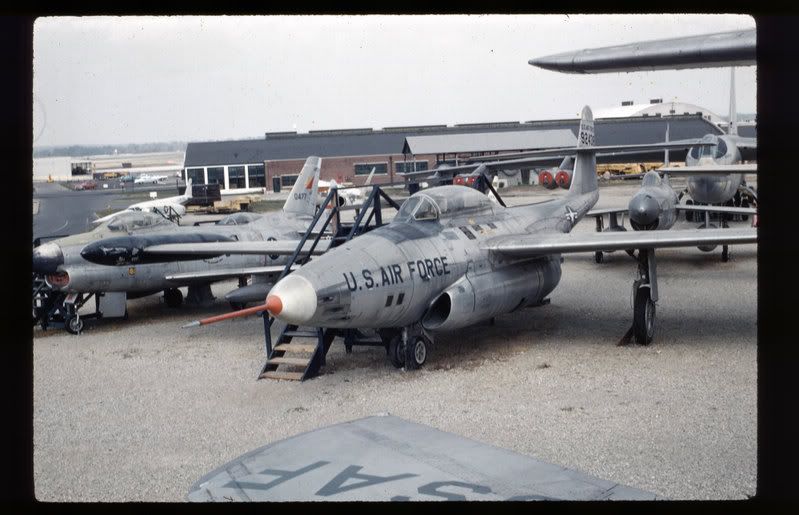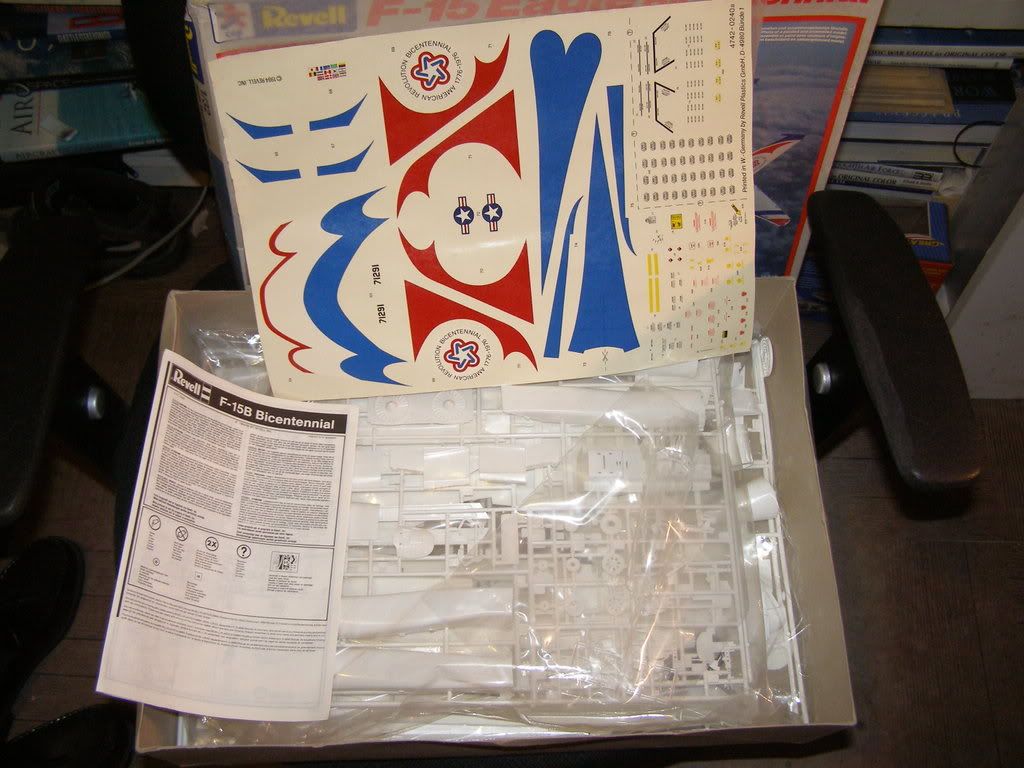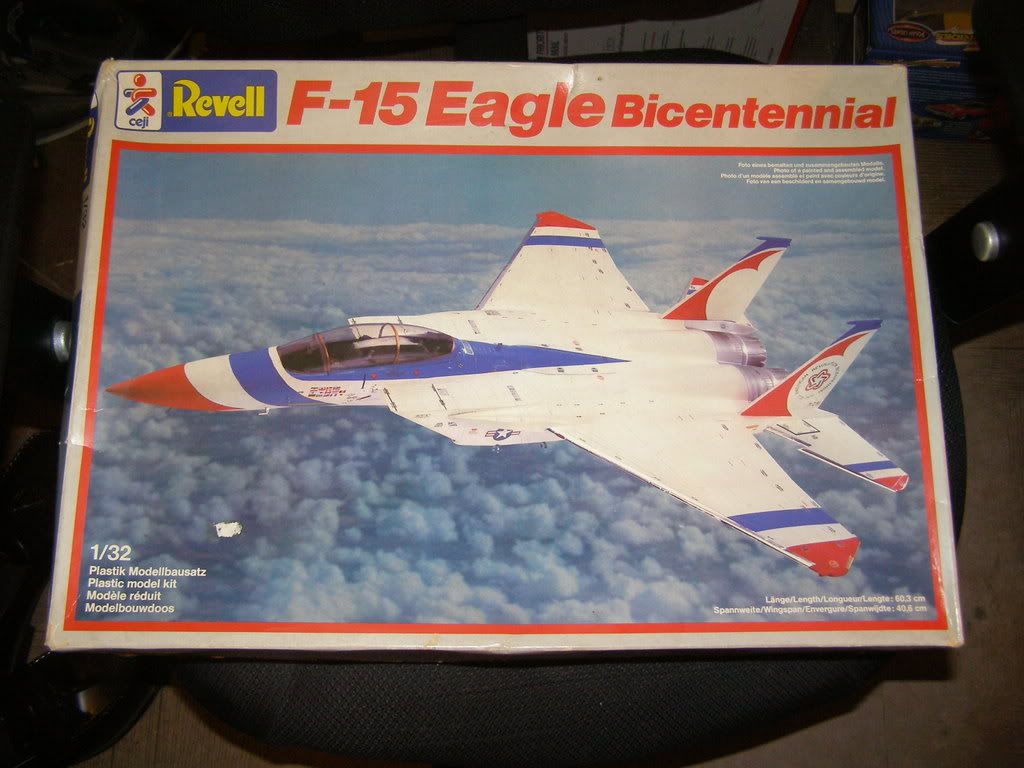
Steve jahn
-
Content Count
265 -
Joined
-
Last visited
Content Type
Profiles
Forums
Calendar
Posts posted by Steve jahn
-
-
I usually don't post museum pics, but this one of an F-89A at the old outdoor Air Force Museum near Fairborn held a little suprise for me when I got it scanned. Possible one of the last photos of the Boeing XB-52, hiding in the background. The slide date is early 60s and both the XB and the YB were unceremoniously scrapped as part of a "base beautification" program initiated by Ladybird Johnson in the mid 60s. How the **** do you "beautify" a museum by scrapping two unique historic aircraft in the collection? And don't start me on the YB-36 either....
Enjoy

Rick L.
I think the F-89 is an "A" model.
49-2438
--------------------------------------------------------------------------------
*Used on bailment for engine development tests to the Allison Engine Division of General Motors at Indianapolis, IN.
*Assigned to the 2759th Flight Test Group, based at Muroc AFB, CA.
*Assigned to the USAF 3077th Evaluation Group, based at Edwards AFB, CA.
*2/15/1951: Damaged in a landing accident due to engine failure at Edwards AFB, CA.
*Used as a support aircraft for the F-89H program.
*6/1957: Given to Edwards AFB as a display aircraft.
Pic of F-89A 49-2438
-
Exactly.
Tranche 1 means the first production specification, Tranche 2 means second production specification etc...
For our friends over the pond, when you hear 'Eurofighter Tranche' think 'F-16 Block'
Vince
Great,Thanks for all the replies.I got a hold on it now.
Steve
-
It's a Collateralized Mortgage Obligation or a companion bond.
In other words - all the countries that want to produce and/or buy EF2000s have shared investment intrests in the building of a predetermined number of aircraft. This is different from the "Block" or configuration type of the aircraft. A Tranche may actually purchase aircraft from several Blocks or configurations.
BTW - There are Block 1 and Block 5 differences that I learned about when the RAF was here back in May. The Block 1 Typhoons have no IR ball to the left of the windscreen while the Block 5s do.
AND - what ever you do - DO NOT call the "Fore-Planes" Canards! I heavily insulted one of the RAF Fairies by calling the Fore-Planes "Canards" . . . "It's not a bloody French aircraft afterall . . . "
I'm still laughing over that one!
ATB -
- Rip -
Here is an excerpt from the new Air international Typhoon insert:
"Some 148 aircraft were built in tranche 1,the last of the core nations was delivered on March 20,2008, a German twin-seater.Austria is to receive nine aircraft from tranche 1 production, with five having been delivered by the end of 2007."
It looked like they used the term to combine block numbers. And then they talk about up-grading Tranche 1 aircraft to tranche 2 standards.
Steve
-
For some reason the word "Tranche" is used to determine the build standard of the eurofighter. Tranche is a financial term so why do they use it for this aircraft?
Steve
-
Hey guys need a hand. does anyone know who makes the older oval shaped center fuel tank for the F-18B? I want to do a USNTPS bird and need the tank
thanks
Andy
I asked that question before and never got a response. The oval tanks were never a production tank anyway.I've only seen FSD aircraft with the tank.Do you have a picture with a USNTPS that has the oval tank on it?
Steve
-
Externally there is no difference between the F4G and the F4B. The G was used as a testing platform for the ILS system, any changes were internal. I think that there was only 12 G's made, and were all later converted back to B's after the system was adopted. As far as I know there are no decals available. Shoudln't be hard to make them, they were all camouflage at the time, two tone green and white underneath. All markings were very subdued, as far as I know there was no squadron markings. I hope this was helpful.
Norm
There was one other difference.There was a retractable radar reflector in front of the nose gear under the nose.It was for the automatic carrier landing capability.
Steve
-
The RM is far closer to the real thing... fact is, once you calibrate your Mk 1 eyeball, the Tamiya's will look just wrong...
I am familiar with the Misawa tanks for the P/F-80. What was the misawa tank for the F-84?
Steve
-
Heck, it looks pretty alien on the ground too. Glat the crew got out ok, that could have been much worse.
It's to bad the ground photograper did'nt follow it to the end.
-
Here's the Tamiya USA contact info. That is probably going to be your best bet. You'll need the number code of the sprue and decal sheet, and you'll have to buy the whole sprue, but that sounds like that's what you need anyways.
Aaron
Great Aaron, Thank you
Steve
-
I have a Tamiya 1/32 F-4J that has damaged parts.Whats the best way to get new clear parts,sprue "E" and a decal set?
Thanks
Steve
-
Has there ever been a resin or vacu-formed kit done of the strait wing one or two seat mock up the the F4H-1?
http://www.boeing.com/defense-space/milita...s/d4e-62637.htm
http://www.boeing.com/defense-space/milita...s/d4e-43697.htm
-
AFAIK, it's one of two colors, either metallic blue-green, or white. The swap from the metallic color to white supposedly came around the FY80 airframes.
I agree with Dave.I just found a photo in the book;Modern Fighting Aircraft F-15.These were those large yellow books published in 1983.Photo shows the production line sometime in 1980 and shows F-15C's with white TEWS area.I think some time in the early production run for the "C" they changed from green to white.
Steve
-
When I built my YF-23 I asked Paul Metz a member of my model club and the test pilot for YF-23 about that. He said that they decided to paint that door red for safety reasons as you mentioned. I guess that when the aircraft was shutdown this door would hang open, thus the concern about saefty when checking the under side of the jet. He said that the door was triangular in shape so they got the idea to add the second triangle thus creating the hourglass shape. He said that it lasted one flight which just happened to be the one in which the photo you mentioned was taken. After that the "higher ups" told them to remove it from the aircraft. The name "Black Widow" had already been given to the aircraft long before this, I was told that it was a tribute to the P-61. Next time I see him I will see if he has a copy of that photo.
Dave Fassett
Look at 3:30 on this video. You can see the markings.
http://www.youtube.com/watch?v=lVG9xgHefzg...feature=related
Also on the Aviation Week and Space technonogy cover on this site: http://www.wci-productions.com/infopg.htm
Steve
-
I bought this kit on Ebay about 5 years ago. This is the only one I have ever scene.It is kit #4742 and was issued in 1984. Any one else have or is this thing super rare?
Steve


-
I saw last year that hasegawa was going to release their TF-104 with the Lockheed demonstator paint scheme sometime soon.Now I can't find anything on it.I know I did'nt miss the issue.Any one know any thing?
steve
-
You are correct sir.
steve
-
USAF 42650 F-15 Weapons Load Crew Chief and trouble shooter.Luke AFB,1980-1984.
Steve
-
I know what you mean about the injection molded one will pop up whwn you paid double for the conversion.I have heard of the conversion you are talking about but have never seen one.I will ask around though.
Steve
-
There really is nothing special about the decals except the yellow "92428".Send me your email and I'll send you a photo of the decals.Steve
-
I'm thinking my chance of getting one is close to zero.I think that sometime the stuff will pope up again no matter what the owner said.Unless he is just going to destroy the inventory.
-
Any one know where one of these might be available? I saw the close out notice the day they closed down.I just have to have one.
Steve
-
I am looking for a decal set for the 1/48 FJ-2 Fury.I think it might have been Superscale 48-117.It was for the two all blue prototypes with the big"754" or "755" on the nose.
Steve
-
Well, I'm making a Falklands Argy Q, and the Hobbycraft kit comes with all the Argy bits. So is it OOP?
The Hobbycraft kit is a "C' even though they list it as a "B".It has the wrong nose for a "B'
Steve
-
Falcon do (or did) a vacform one. Still available and if it's anything like their other stuff good quality. Cheaper too.
Try Aeroclub, Hannants or Google......
Yes,I have that one.But I really want that resin set and the decals.
steve


Saw an interesting plane the other day
in Research Corner
Posted
What exact day was it and what airport was it landing at?
Steve